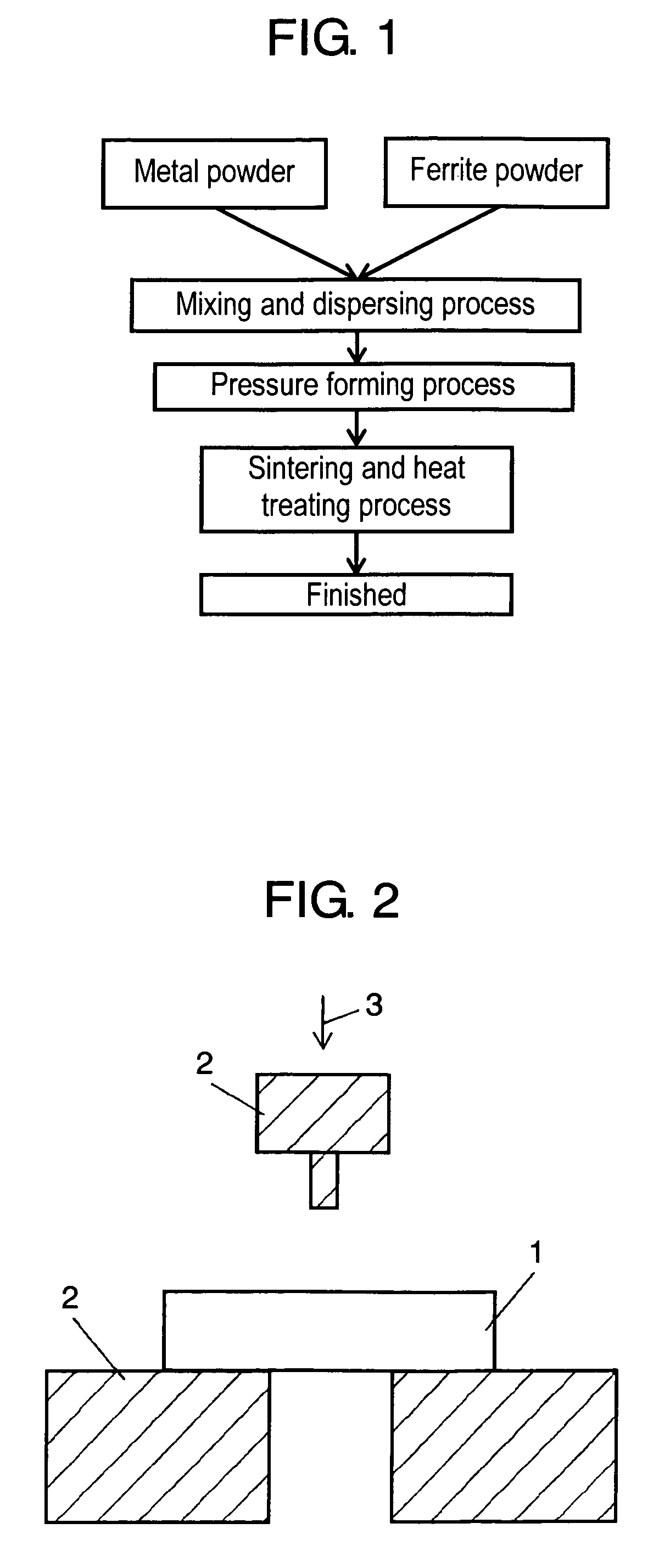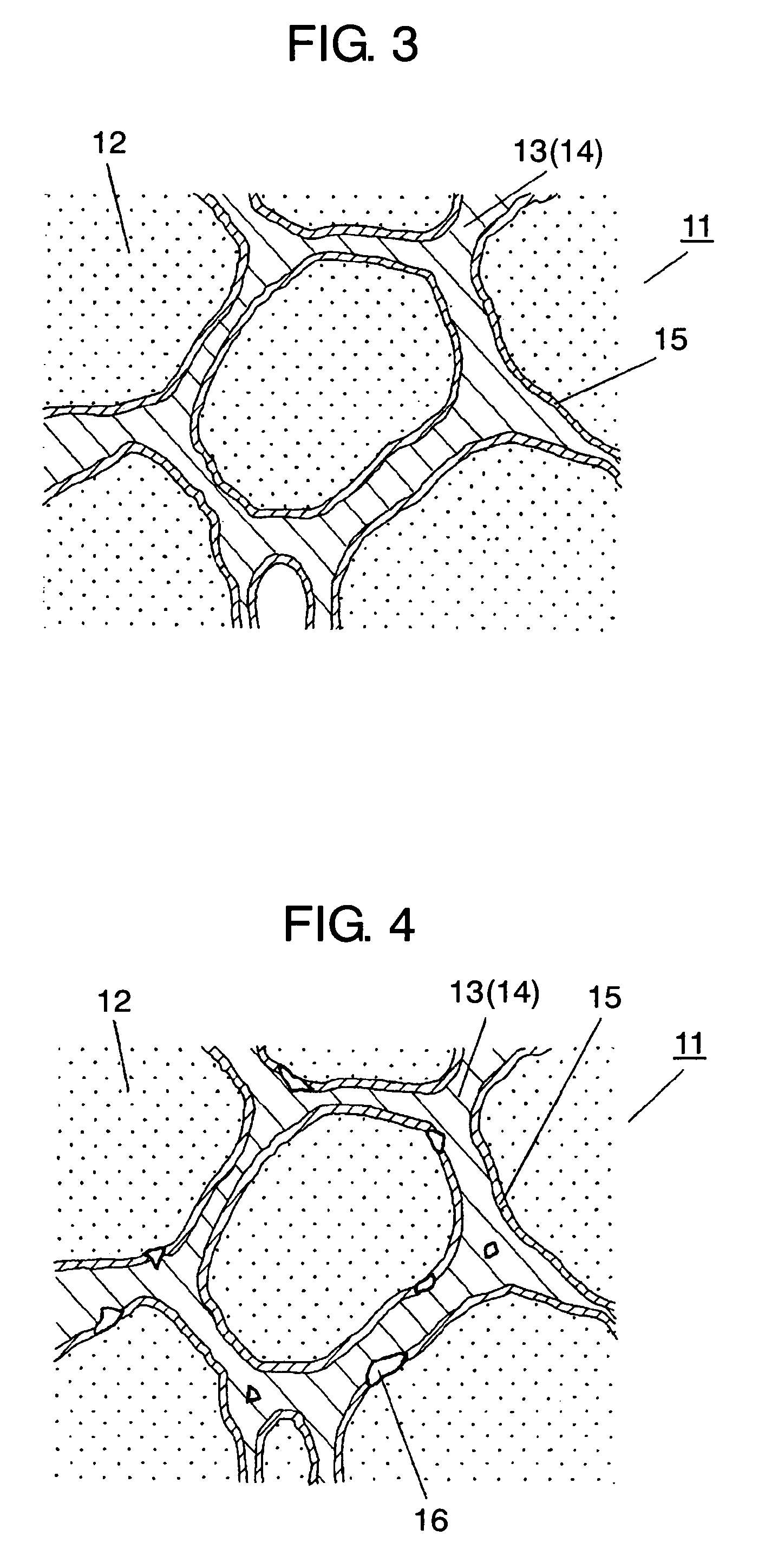Composite sintered magnetic material, its manufacturing method, and magnetic element using composite sintered magnetic material
a technology of composite sintered magnetic material and manufacturing method, which is applied in the direction of magnetic materials, magnetic bodies, textiles and paper, etc., can solve the problems of low saturation magnetic flux density of ferrite magnetic core, poor direct-current superposition characteristic, and noise generation
- Summary
- Abstract
- Description
- Claims
- Application Information
AI Technical Summary
Benefits of technology
Problems solved by technology
Method used
Image
Examples
embodiment 1
[0046]In the embodiment 1, as shown in the block diagram of FIG. 1, ferrite powder of 0.6 μm in average grain size is added by 15 wt % to metal powder of 8 μm in average grain size, and both are mixed and dispersed. After that, pressure forming, sintering, and heat treatment are performed, thereby, manufacturing a composite sintered magnetic material having a shape of about 15 mm in outer dimension, 10 mm in bore diameter, and 3 mm in height.
[0047]FIG. 7 shows the characteristics of a composite sintered magnetic material in the embodiment 1. Samples No. 6, 7 are powder magnetic cores using metal powder, and samples No. 8, 9 are ferrite magnetic cores. Samples No. 6 to 9 are the examples for comparison with the composite sintered magnetic material in the embodiment 1. The compositions of metal powder and ferrite powder used in the embodiment 1 are as mentioned in FIG. 7.
[0048]In FIG. 7, permeability was measured at frequency 100 kHz by using an LCR meter, and core loss was measured a...
embodiment 2
[0077]In the embodiment 2 of the present invention, the surface of metal powder 12 is coated with ferrite layer 13, for example, by a non-electrolytic plating, coprecipitation, mechanofusion, evaporation, sputtering process, and the like. After that, metal powder 12 coated with ferrite layer 13 is compacted under pressure and the compact obtained is sintered, thereby forming diffusion layer 15 between metal powder 12 and ferrite layer 13. In this way, it is possible to omit the mixing and dispersing process from the manufacturing method for composite sintered magnetic material 11 in the embodiment 1. Also, by using the method shown in the embodiment 2 of the present invention, it is possible to assure the existence of ferrite layer 13 between metal powder 12. As a result, it becomes possible to realize excellent high-frequency characteristic while assuring the insulation in composite sintered magnetic material 11.
[0078]FIG. 5 shows a block diagram of the manufacturing method for com...
embodiment 3
[0086]In the embodiment 3 of the present invention, raw ferrite is used instead of ferrite powder 14. It is possible to use NiO, Fe2O3, ZnO, CuO, MgO, and MnCo3 as raw ferrite. In this case, predetermined amounts of metal powder 12 and raw ferrite are measured, then mixed and dispersed, followed by compacting under pressure, and the compact is sintered to change the raw ferrite into ferrite, and diffusion layer 15 can be formed between metal powder 12 and ferrite layer 13.
[0087]Besides the above method, in the manufacturing method shown in the embodiment 2, it is also possible to form diffusion layer 15 between metal powder 12 and ferrite layer 13 by coating the surface of metal powder with raw ferrite instead of ferrite powder 14, for example, by non-electrolytic plating, coprecipitation, mechanofusion, evaporation, sputtering process and the like, followed by pressure forming metal powder 12 coated with the raw ferrite and sintering the compact obtained.
[0088]Further, it is possib...
PUM
| Property | Measurement | Unit |
|---|---|---|
| temperature | aaaaa | aaaaa |
| grain size | aaaaa | aaaaa |
| grain size | aaaaa | aaaaa |
Abstract
Description
Claims
Application Information
 Login to View More
Login to View More - R&D
- Intellectual Property
- Life Sciences
- Materials
- Tech Scout
- Unparalleled Data Quality
- Higher Quality Content
- 60% Fewer Hallucinations
Browse by: Latest US Patents, China's latest patents, Technical Efficacy Thesaurus, Application Domain, Technology Topic, Popular Technical Reports.
© 2025 PatSnap. All rights reserved.Legal|Privacy policy|Modern Slavery Act Transparency Statement|Sitemap|About US| Contact US: help@patsnap.com



